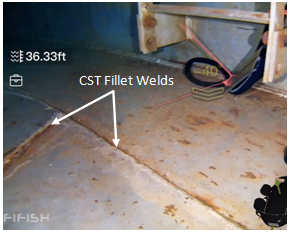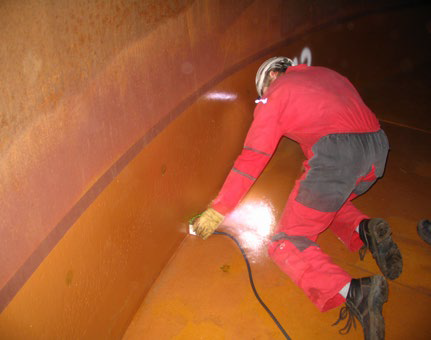Why Regular Tank Welding Inspection is Critical for Structural Stability
Why Regular Tank Welding Inspection is Critical for Structural Stability
Blog Article
Comprehensive Overview to Effective Storage Tank Welding Inspection Techniques and Best Practices for Quality Control
In the realm of container welding, extensive assessment strategies are paramount for safeguarding architectural stability and making sure compliance with sector regulations. As we check out these important elements, it becomes clear that a positive assessment method is not just helpful, yet important for operational success in settings dealing with hazardous products.
Relevance of Tank Welding Examination

Container welding assessment offers as a preventative action, determining potential defects such as splits, porosity, or incorrect joint infiltration before they escalate right into serious issues. Normal inspections not only adhere to sector guidelines and standards however likewise enhance the long life of the tanks, lowering the requirement for pricey repair work or replacements.

Visual Assessment Strategies
Utilizing organized aesthetic examination techniques is critical for assessing the quality and integrity of welded joints in storage tanks. This technique works as the first line of protection in identifying potential flaws such as splits, damages, and not enough infiltration. The inspector ought to approach the task with a keen eye, using proper devices like multiplying glasses, flashlights, and mirrors to boost visibility.
During the assessment process, the examiner must review the weld account, guaranteeing it complies with specified standards and standards (Tank Welding Inspection). This includes examining the bead width, elevation, and blend with the base product. Inspectors should also pay attention to the bordering locations for indications of thermal distortion or contamination that may impact the weld's performance
Documentation of searchings for is crucial; examiners should videotape any kind of abnormalities, classifying them by seriousness for further evaluation. This systematic method not just help in prompt flaw recognition but additionally adds to long-term quality control by guaranteeing conformity with market standards. Routine training and calibration of aesthetic examination strategies additionally boost the dependability of analyses, eventually leading to more secure and a lot more resilient tank structures.
Non-Destructive Testing Techniques
Non-destructive testing (NDT) approaches are often employed in container welding assessments to examine the integrity of bonded joints without endangering their structural honesty. These strategies are important for determining issues such as fractures, gaps, and additions that could bring about devastating failings if left undiscovered.
Usual NDT methods consist of ultrasonic testing (UT), which makes use of high-frequency acoustic waves to discover internal problems; navigate to this website radiographic testing (RT), using X-rays or gamma rays to picture weld frameworks; and magnetic bit screening (MT), which discloses surface and near-surface stoppages in ferromagnetic products (Tank Welding Inspection). Fluid penetrant testing (PT) is additionally widely made use of, efficient in finding surface-breaking issues by applying a fluorescent or color comparison dye
Each NDT approach has its particular applications and benefits, making it essential for examiners to choose the suitable technique based on the product and the kind of weld being reviewed. The integration of these NDT techniques right into the examination procedure enhances the overall high quality guarantee structure, guaranteeing that welded storage tanks meet safety and security and efficiency standards. Eventually, NDT plays an important duty in maintaining the integrity and durability of storage tank frameworks in various commercial applications.

Documentation and Coverage
Making certain extensive documents and reporting throughout container welding inspections is crucial for preserving compliance with market standards and assisting in reliable interaction amongst stakeholders. Appropriate paperwork functions as an find more information extensive document of examination tasks, searchings for, and any kind of rehabilitative activities taken throughout the welding process. This info is necessary not just for high quality assurance but also for audits and regulatory testimonials.

A well-structured assessment record should consist of information such as the date of assessment, names of inspectors, welding procedures utilized, products made use of, and any kind of deviations from developed requirements. In addition, pictures and layouts can improve the clarity of the site record, supplying visual context to the searchings for. It is also essential to document any type of non-conformities along with their resolution, making certain that all stakeholders are notified of possible risks and the actions taken to reduce them.
Additionally, maintaining a centralized database for all examination reports permits simple access and review, cultivating a culture of openness and responsibility. By prioritizing careful paperwork and coverage, companies can not only maintain quality control however additionally enhance their reputation within the market, inevitably resulting in improved safety and operational performance.
Continual Improvement Practices
Continuous enhancement practices are vital for boosting the top quality and effectiveness of tank welding inspections. Executing a systematic technique to assess and refine inspection approaches cultivates a culture of quality control within the company. One reliable strategy includes normal training and upskilling of evaluation workers to stay abreast of the most recent welding modern technologies and standards. This makes certain assessors have the required knowledge and skills to identify problems precisely.
Moreover, making use of data-driven evaluation allows organizations to track examination results, identify fads, and pinpoint locations for renovation. Employing tools such as root cause analysis can help in recognizing the underlying problems resulting in flaws, making it possible for targeted treatments. Furthermore, obtaining feedback from evaluation teams and stakeholders creates a collective setting that urges innovative options.
Integrating sophisticated technologies, such as computerized examination systems and real-time surveillance, can substantially enhance the precision and speed of inspections. Regular audits of the examination processes additionally add to a society of responsibility and continuous improvement. Ultimately, these constant renovation techniques not only boost the quality of storage tank welding inspections however also add to overall operational excellence and client complete satisfaction.
Verdict
In verdict, efficient tank welding assessment is critical for ensuring the structural integrity and security of storage space systems, specifically those handling dangerous materials. Utilizing a mix of visual assessment strategies and non-destructive testing approaches promotes the very early identification of flaws, consequently preserving conformity with sector standards.
Report this page